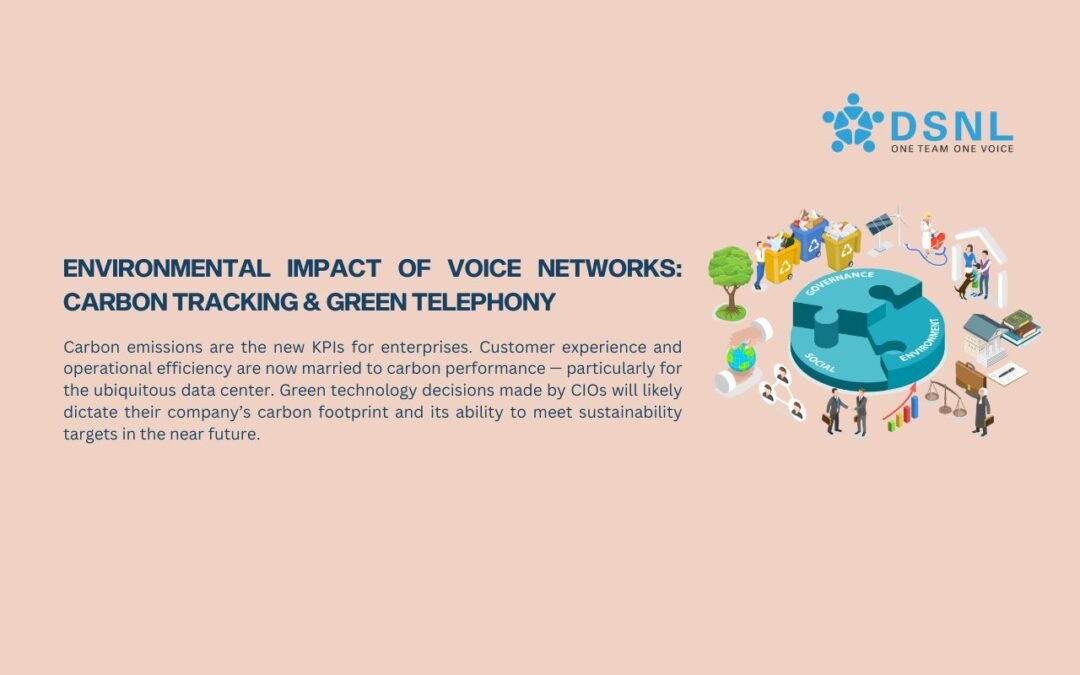Carbon emissions are the new KPIs for enterprises. Customer experience and operational efficiency are now married to carbon performance — particularly for the ubiquitous data center. Green technology decisions made by CIOs will likely dictate their company’s carbon footprint and its ability to meet sustainability targets in the near future.
There are several benefits in tracking telephony powered by the Internet of Things (IoT) and understanding carbon data. Carbon tracking can help reduce a telecom service provider’s ecological impact and build resiliency while allowing companies to be more efficient with their processes.
Carbon Tracking Explained
Carbon tracking, as the name suggests, is the real-time monitoring of carbon emissions or output, using advanced telemetry or log analysis. It allows communication systems to monitor, measure, and track carbon emissions across the entire telephony ecosystem, including private branch exchanges (PBX), gateways, and IP transmission systems, as well as call recording and storage in use and at rest.
Carbon data or metrics are then used to report emissions per customer to enterprise leaders so they can make decisions on switching energy suppliers to solar, wind, or other green sources.
Carbon Tracking For Voice Networks
Traditional voice networks are dependent on a range of data centers, legacy, and modernized communication systems. This includes complex multi-site distributed data centers, internet-exchange-optimized IP-PBX, MPLS, and Wi-Fi systems.
Carbon Tracking Steps
The process of carbon tracking and building greener communication systems follows these major steps.
- Monitor & Measure.Install smart energy monitoring and management platforms with a control interface in every data center — even small and remote ones that may be overlooked when it comes to energy optimization.
- Analyze. Audit the full footprint and source of power for every communication node and tower.
- Optimize. Monitor the emissions produced by real-time voice and data communication, including both when it’s in use and in storage. Measure datacenter usage such as kWh per capacity, the source of generation of kWh (grid mix), server room temperatures, cooling equipment efficiency, and possible supply of renewable energy contracts. Ensure demand response systems and grid notification and event systems are integrated.
- Compare carbon emissions with similar companies and industry norms, target savings, and track progress.
- Align and report carbon reduction and green operations to international carbon-reporting and industry standards, such as Sustainability and Net-Zero reporting.
Green Telephony: Carbon-Neutral Telephony
Carbon-neutral telecommunications, also known as “green telephony,” can be built by adding carbon tracking as part of an overall cloud, software, and voice networking architecture and operations. Cloud-powered, green communication systems with carbon tracking can be used to measure and report carbon and energy data with every call or data byte, right down to the individual endpoints or devices.
Switching, Data Centers, and Green Telephony
The voice and data center network that powers communications services around the world needs to be reimagined to reduce carbon emissions. Switching hardware for PBX, long-distance, and wireless transmission systems requires 24×7 cooling and air conditioning.
Sustainable operations for voice networks start with a multi-pronged approach. The entire premise of modern voice switching is moving to a virtualized PBX or cloud platform that uses as little computing power and energy. Enterprise switches, racks, and PBX hardware running network media functions can be consolidated to save energy, with the next phase being the software-based unified platform.
This can also help virtualize most network media-intensive functions, such as switching and routing. Companies also need to take a closer look at their larger and smaller data centers powering much of this communications infrastructure, PBX, and analytics.
Choose a Telecom Service Provider that Supports Carbon-Tracking
As switching and voice architecture are moving to the cloud, end-to-end communications management and green telephony can only be achieved by cloud-ready or hyperscale providers. Enabling real-time carbon tracking requires granular data on energy use, remote control, and supply chain visibility that only these providers can offer.
They are fully virtualized, build green data centers in major markets with flexible renewable power purchase agreements or energy supply contracts, and have strong grid supply visibility and management tools. Telecom service providers that support and offer carbon-tracker services and tools in their communications services are also worth looking at.
Conclusion
Carbon tracking for telecommunications and green voice telephony can allow companies to reduce their carbon emissions, track energy use in real-time, set reduction goals, and report to customers and regulators. Green telephony has many business advantages.
Not only do software-defined, cloud-ready PBX and voice solutions provide cleaner data centers, but energy reduction from voice switching has economic value when it comes to corporate sustainability goals, employee attraction and retention, customer acquisition, and green brand marketing. Contact us today to learn more about the environmental impact faced at voice networks.

